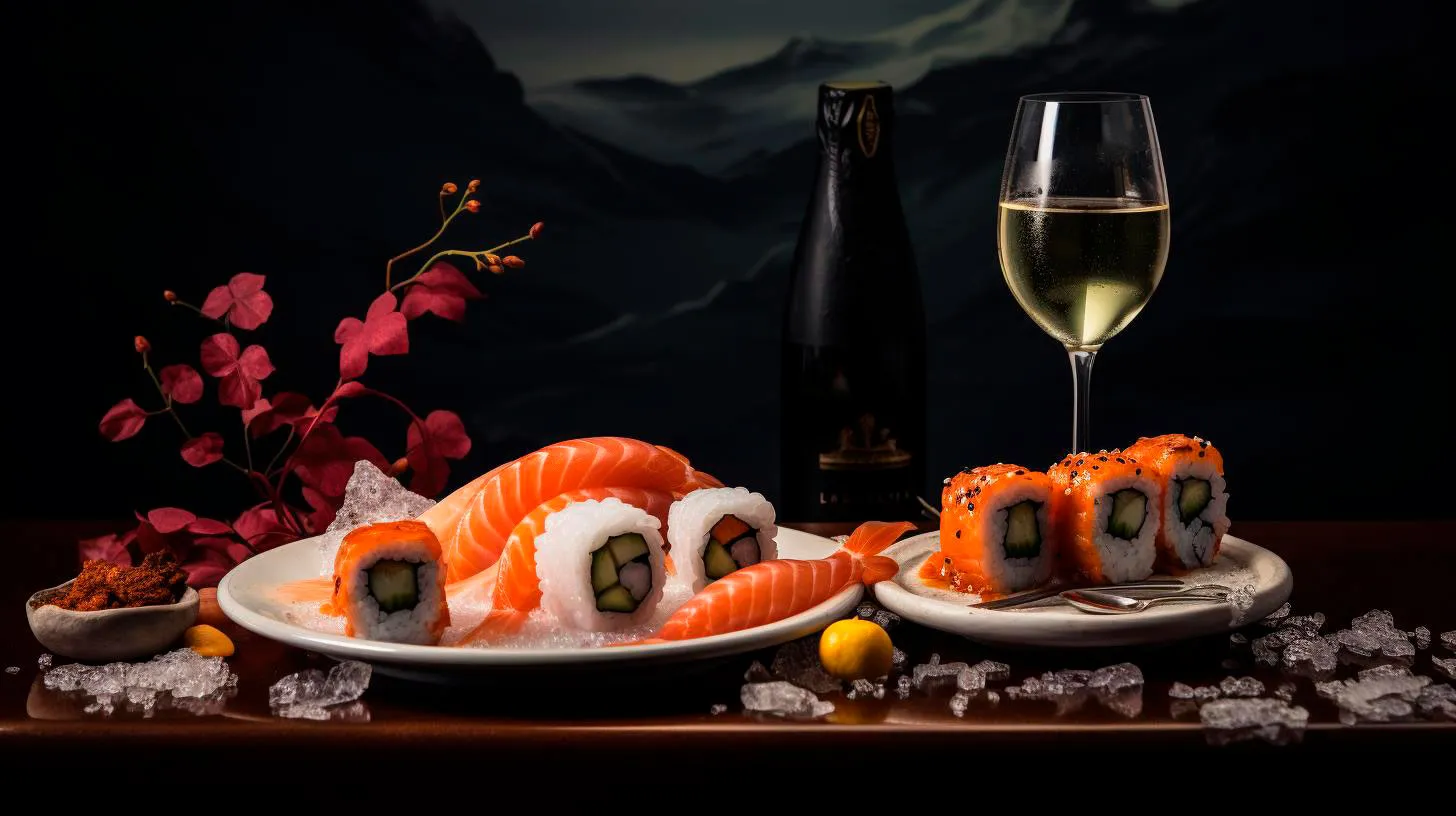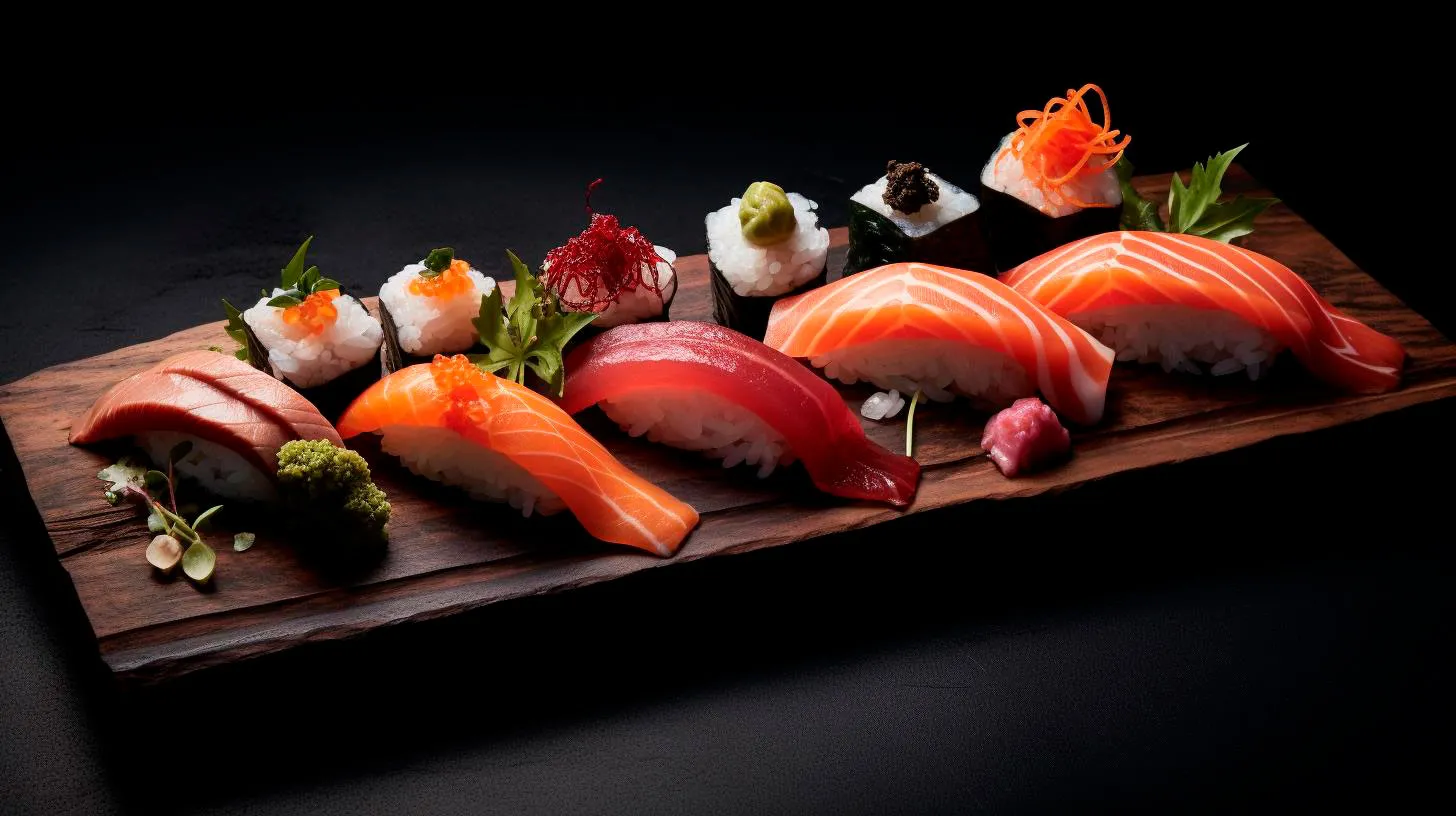Savoring Edo: How Sushi Transcends Taste to Preserve Japan’s Rich Heritage
In this article, we will explore how sushi transcends taste to preserve Japan’s vibrant past, offering a truly immersive experience for those who savor it.
The Origins of Sushi and Its Connection to Edo
The history of sushi dates back centuries, with its origins rooted in the vibrant streets of Edo, present-day Tokyo. Edo, known for its bustling markets and flourishing food scene, played a significant role in shaping sushi as we know it today. The particular style of sushi that emerged during the Edo period, known as Edo-mae sushi, revolutionized the culinary world and set the foundations for modern sushi.
Edo-mae sushi emphasized the use of freshly caught fish, expertly sliced and paired with hand-pressed vinegared rice. This technique not only enhanced the flavors but also extended the shelf life of the fish, allowing it to be enjoyed beyond its peak freshness. The craftsmanship and attention to detail displayed in Edo-mae sushi became synonymous with the artisanal skills that defined the Edo period.
Key Takeaway: Edo-mae sushi, originating from Japan’s Edo period, revolutionized the culinary world with its use of freshly caught fish and expertly prepared rice.
Sushi as a Reflection of Japanese Philosophy
One remarkable aspect of sushi is its ability to embody the profound philosophy and values deeply ingrained in Japanese culture. Every aspect of sushi preparation, from selecting the finest ingredients to presenting each piece with utmost precision, reflects the principle of “Wabi-sabi.” This Japanese aesthetic philosophy celebrates imperfections and impermanence, emphasizing the beauty found in simplicity.
Sushi’s presentation, often showcased on elegant wooden platters or lacquerware, also pays homage to traditional Japanese tea ceremonies. The meticulous arrangement of sushi represents harmony and balance—a visual feast that complements the flavors experienced upon consumption.
Key Takeaway: Sushi reflects the Japanese philosophy of Wabi-sabi, celebrating imperfections and impermanence, while also embodying harmony and balance.
Sushi: An Intangible Cultural Heritage
In 2013, sushi gained a significant recognition as it was added to the UNESCO Intangible Cultural Heritage list. This prestigious acknowledgment reaffirmed sushi’s cultural significance and the artisans’ dedication to preserving traditional techniques passed down through generations. It also shed light on the role of sushi in fostering social connections and promoting sustainable food practices.
Sushi’s legacy extends far beyond its taste. It serves as a link between past and present, connecting individuals to their cultural roots while embracing the evolving culinary landscape. From traditional sushi bars in Japan to contemporary fusion restaurants worldwide, sushi’s adaptability and willingness to integrate with diverse cultures mark its enduring appeal.
Key Takeaway: Sushi’s inclusion in the UNESCO Intangible Cultural Heritage list speaks volumes about its cultural significance, emphasizing its role in fostering social connections and promoting sustainable food practices.
Preserving Japan’s Rich Heritage Through the Savoring of Sushi
While sushi certainly satiates our taste buds, it goes beyond a mere gastronomic experience. By indulging in sushi, we not only enjoy its subtle flavors but also embark on a journey through Japan’s rich history and cultural traditions.
To fully appreciate the essence of sushi, one must acknowledge the meticulous craftsmanship that enables its creation. From the early mornings of Tsukiji fish market, selecting the finest catch, to the seasoned hands of sushi chefs, delicately molding each piece, sushi encapsulates the dedication and passion of its creators.
Moreover, sushi provides a platform for cultural exchange. As it transcends borders and finds its place in various international culinary scenes, sushi becomes a medium through which cultural understanding and appreciation can flourish. It fosters connections between people from diverse backgrounds, enabling conversations and exchanges that celebrate different traditions.
Ultimately, savoring sushi is not only a delightful experience for the senses, but it is also an opportunity to preserve Japan’s rich heritage and ensure its enduring legacy for generations to come.
Key Takeaway: Sushi allows us to delve into Japan’s history and cultural traditions, while also serving as a platform for cross-cultural exchanges and preserving its legacy.
- Sushi originated from Japan’s Edo period with Edo-mae sushi being the precursor of modern sushi.
- Sushi reflects the Japanese philosophy of Wabi-sabi, celebrating imperfections and impermanence.
- Sushi was recognized as an intangible cultural heritage by UNESCO, emphasizing its cultural significance and promoting sustainable food practices.
- Savoring sushi is a unique opportunity to appreciate the craftsmanship involved and contribute to the preservation of Japan’s rich heritage.
- Sushi fosters cultural exchange, bringing people together and promoting understanding across diverse backgrounds.
Sushi’s evolution transcends taste, intertwining cultural heritage, philosophy, and culinary artistry. By savoring sushi, we pay homage to Japan’s history and traditions, celebrating the craftsmanship and cultural exchange it embodies. Whether indulging in traditional omakase or exploring innovative sushi creations, each bite becomes a testament to the enduring legacy of Edo and the incredible journey that sushi has embarked upon.
The Art of Nigiri: Aesthetics and Symbolism in Traditional Japanese Sushi
But nigiri is more than just a delicious treat; it is also infused with rich symbolism and aesthetic values. In this article, we dive deep into the world of nigiri, exploring its aesthetics, symbolism, and significance in traditional Japanese sushi culture.
The Aesthetics of Nigiri
One cannot help but admire the visual appeal of nigiri. From the vibrant colors to the meticulous presentation, every aspect is carefully designed to stimulate the senses. Here are some key elements that contribute to the aesthetics of nigiri:
- Color Palette: Nigiri showcases an array of colors, ranging from the ruby-red hue of tuna to the delicate pink of salmon and the pearly white of shrimp. These contrasting colors not only make the dish visually appealing but also provide a harmonious balance of flavors.
- Texture: A good piece of nigiri offers a delightful contrast in texture. The softness of the fish, the slight chewiness of the rice, and the subtle crunch of condiments like sesame seeds or tobiko (fish roe) create a captivating mouthfeel.
- Shapes and Sizes: Nigiri is carefully shaped into bite-sized pieces, each with its own unique appearance. The oval shape is the most common, resembling a miniature pillow. However, chefs often experiment with different shapes, adding a touch of creativity to their creations.
- Presentation: Nigiri is typically presented on a beautiful plate or sushi board, accompanied by garnishes such as shiso leaves or microgreens. The arrangement of the sushi pieces emphasizes symmetry and balance, adding to the overall aesthetic appeal of the dish.
Key Aesthetic Takeaway: Nigiri’s meticulous arrangement, vibrant colors, and enticing textures make it a feast for both the eyes and the palate.
The Symbolism of Nigiri
Japanese cuisine is infused with symbolism, and nigiri is no exception. Each ingredient in nigiri holds significance, reflecting cultural values and beliefs. Here are a few examples:
- Tuna: Often regarded as the king of sushi, tuna represents strength and determination. In Japanese culture, tuna is considered a powerful and noble fish.
- Salmon: Symbolizing resilience and determination, salmon is admired for its ability to swim upstream against strong currents. This resilience is admired and aspired to in Japanese culture.
- Egg: The tamago (sweet egg omelet) in nigiri represents new beginnings. It is believed to bring good luck and symbolizes the start of a promising new chapter.
- Shrimp: Shrimp symbolizes longevity and prosperity. It is often included in celebratory dishes to wish the recipient a long and prosperous life.
Key Symbolic Takeaway: Nigiri’s diverse ingredients carry deep cultural symbolism, adding layers of meaning to the dining experience.
The Significance of Nigiri in Japanese Sushi Culture
Nigiri showcases the technical skills and expertise of sushi chefs, who undergo years of training to perfect their craft. It is considered the heart and soul of traditional sushi culture. Here are some key reasons why nigiri holds such significance:
- Preservation of Tradition: Nigiri embodies the essence of traditional Japanese sushi. It is a testament to the commitment of sushi chefs in preserving the customs and techniques passed down through generations.
- Attention to Detail: Every step of preparing nigiri, from selecting the freshest fish to molding the rice, requires meticulous attention to detail. This dedication to perfection sets nigiri apart as a true work of art.
- Experience and Expertise: The art of nigiri cannot be mastered overnight. Sushi chefs spend years honing their skills, mastering the delicate balance of flavors and textures that nigiri demands.
- Interaction and Connection: Nigiri is often served directly from the chef’s hands to the guest, creating a personal and interactive dining experience. This connection between the chef and the customer adds to the cultural significance of nigiri.
Key Takeaways: Nigiri represents the preservation of tradition, meticulous attention to detail, the expertise of sushi chefs, and the connection between chef and guest.
As you savor each piece of nigiri, take a moment to appreciate the artistry and symbolism it embodies. Nigiri is not merely a culinary delight; it is a reflection of Japanese culture, aesthetics, and values. So, the next time you indulge in a plate of nigiri, remember that you are not only experiencing a delicious meal but also immersing yourself in the rich heritage of Japanese sushi.
Sushi as an Icon: Exploring the Interplay between Food and Art in Japanese Society
The Artistry of Sushi
Sushi is not just a meal; it is a work of art that requires precision, skill, and creativity. Each piece of sushi is carefully crafted by skilled chefs, known as Itamae, who utilize their expertise to create visually appealing and delectable masterpieces. The presentation of sushi is as important as its taste, with the arrangement of colors, textures, and shapes forming an integral part of the dining experience.
- Visual Delight: The harmonious colors of sushi, combined with its intricate presentation, make it a feast for the eyes. Vibrant ingredients such as fresh fish, crunchy vegetables, and delicate garnishes are meticulously arranged on a bed of vinegared rice.
- Attention to Detail: Itamae focus not only on taste but also on aesthetic appeal. They carefully slice the fish, ensuring it is perfectly sized for each sushi piece, while also incorporating artistic techniques such as sculpting decorative elements to elevate the visual impact.
- Balance and Symmetry: The art of sushi goes beyond the individual pieces. The overall plating seeks to achieve balance and symmetry, with exact proportions used to create a visually pleasing composition. This attention to detail enhances the dining experience and leaves a lasting impression.
Sushi as a Cultural Symbol
Sushi has become more than just a dish; it symbolizes Japanese culture and tradition. It is deeply rooted in the country’s history and has evolved over centuries, adapting to changing regional preferences and culinary techniques. As such, sushi holds several cultural significances:
- Reflection of Nature: Sushi’s emphasis on fresh, seasonal ingredients reflects the Japanese appreciation for nature and its changing seasons. It serves as a reminder of the country’s agricultural heritage and sustainable food practices.
- Attention to Craftsmanship: Just as traditional Japanese art forms emphasize meticulous craftsmanship, sushi-making requires a high level of skill, precision, and dedication. It is regarded as a form of art that reflects the Japanese value of mastering one’s craft.
- Communal Spirit: Sushi is often enjoyed in a communal setting, such as at sushi bars or during celebratory gatherings. This sharing of food fosters a sense of togetherness, reinforcing the importance of community and social connections in Japanese society.
Key Takeaways
Sushi’s journey from being a mere dish to an iconic representation of Japanese culture exemplifies the interplay between food and art in society. Its artistry and cultural significance make it a captivating subject of exploration. Here are some key takeaways:
- The art of sushi lies not only in its taste but also in its presentation, with visual appeal being an essential aspect.
- Sushi showcases the precision, balance, and attention to detail that characterizes traditional Japanese craftsmanship.
- Through its use of fresh, seasonal ingredients, sushi reflects the Japanese reverence for nature and sustainable food practices.
- Sushi’s communal nature highlights the importance of social connections and togetherness in Japanese society.
As an iconic dish, sushi continues to inspire both food enthusiasts and artists alike. Its fusion of culinary excellence and aesthetic beauty has made it a celebrated symbol of Japanese culture and a captivating subject in the realm of food and art.
Sources
– Japan National Tourist Organization. Food in Japan. Retrieved from https://www.japan.travel/en/learn/food/
– SushiSushi. A Beginner’s Guide to Sushi. Retrieved from https://www.sushisushi.co.uk/blogs/sushi-beginners-guide/what-is-sushi
– FluentU. Japanese Culture: Art, History and Society. Retrieved from https://www.fluentu.com/blog/japanese/japanese-culture/
Sushi as a Culinary Canvas: The Artistic Significance in Japanese Culture
In this blog article, we will delve into the fascinating world of sushi as a culinary canvas, exploring its artistic elements, cultural significance, and the mesmerizing experience it offers. Get ready to discover the delightful fusion of aesthetics and flavors that sushi brings to the table.
The Artistry Behind Sushi
Creating sushi is not simply about mixing raw fish and rice; it involves a meticulous process that showcases the skill and precision of the sushi chef. Here are some key elements of the artistry behind sushi:
- Presentation: Sushi is meticulously arranged to create visually stunning plates. Chefs carefully select ingredients that complement each other in terms of color, shape, and texture, resulting in stunning culinary masterpieces.
- Knife Skills: Sushi chefs undergo years of training to perfect their knife skills. The way they slice the fish and cut the vegetables not only affects the taste and texture but also contributes to the overall aesthetics of the dish.
- Garnish and Decoration: Sushi is often adorned with edible garnishes, such as microgreens, flowers, or intricately carved vegetables. These additions add an extra layer of beauty and enhance the visual appeal of the dish.
The Cultural Significance of Sushi
Sushi’s artistic significance extends beyond its visual appearance. It embodies the essence of Japanese culture and tradition, reflecting centuries of culinary craftsmanship. Here are a few reasons why sushi holds cultural importance:
- Precision and Discipline: Sushi-making is a reflection of Japan’s emphasis on precision and discipline. The attention to detail required by sushi chefs is a testament to the country’s dedication to excellence.
- Nature Appreciation: Traditional sushi often incorporates seasonal ingredients, reflecting Japan’s deep-rooted appreciation for nature. It celebrates the diversity and freshness of local produce, creating a connection between the plate and the natural world.
- Harmony and Balance: Sushi embodies the principle of “washoku” – the harmony between ingredients and flavors. Each sushi roll or nigiri aims to create a balance of tastes, textures, and colors, ensuring a well-rounded dining experience.
The Mesmerizing Experience
Indulging in sushi is an experience that tantalizes not only the taste buds but also the visual senses. Here are some key takeaways that make the sushi experience truly mesmerizing:
- Visual Delight: The artistic presentation of sushi elevates the dining experience. The vibrant colors, intricate patterns, and meticulous arrangement create a feast for the eyes.
- Flavorful Combinations: Sushi offers an array of flavor profiles that range from delicate and subtle to bold and umami-rich. Each bite unfolds a harmonious blend of tastes, leaving a lasting impression.
- Culinary Innovation: Sushi has evolved over time, embracing new ingredients and techniques while still honoring its traditional roots. Sushi chefs continually push the boundaries of creativity, resulting in innovative and exciting flavor combinations.
In conclusion, sushi is not just food; it is a fine art form that captures the essence of Japanese culture. From the intricate presentation to the cultural symbolism, sushi represents the harmony between aesthetics and gastronomy. So, the next time you savor a piece of sushi, take a moment to appreciate the masterful craftsmanship and cultural significance behind it.



